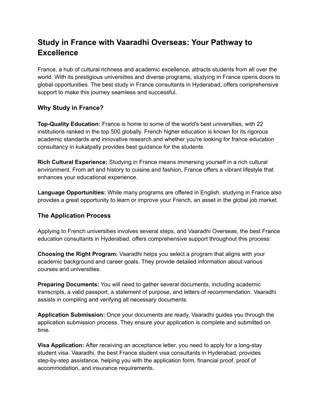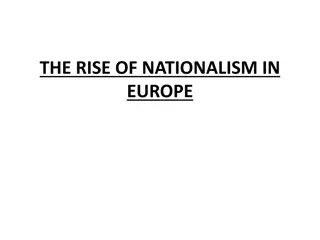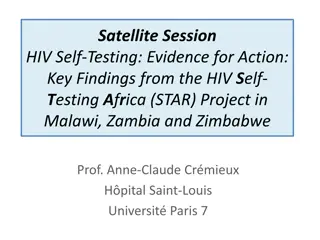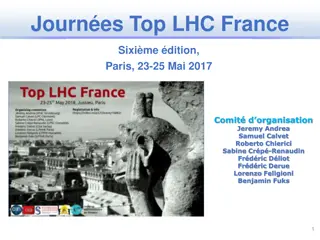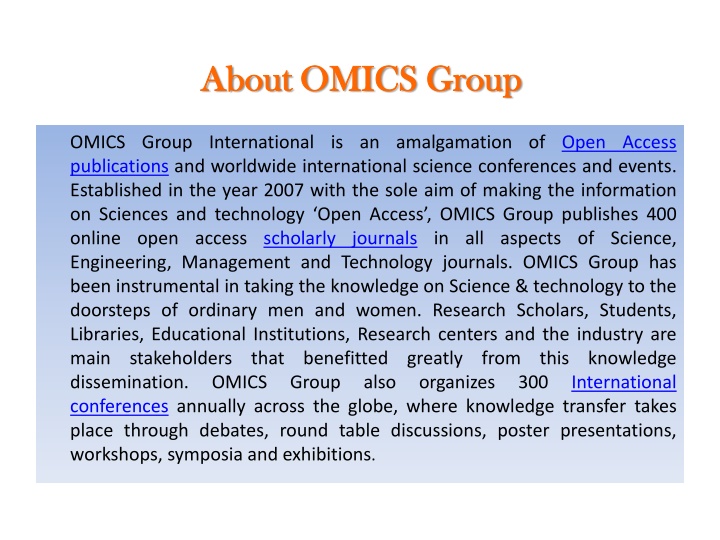
Global Impact of OMICS Group in Science and Technology
"OMICS Group International, established in 2007, is a leading provider of open access publications and international science conferences. With a vast array of journals and events, it has revolutionized the dissemination of knowledge in diverse fields of Science, Engineering, Management, and Technology globally."
Download Presentation

Please find below an Image/Link to download the presentation.
The content on the website is provided AS IS for your information and personal use only. It may not be sold, licensed, or shared on other websites without obtaining consent from the author. If you encounter any issues during the download, it is possible that the publisher has removed the file from their server.
You are allowed to download the files provided on this website for personal or commercial use, subject to the condition that they are used lawfully. All files are the property of their respective owners.
The content on the website is provided AS IS for your information and personal use only. It may not be sold, licensed, or shared on other websites without obtaining consent from the author.
E N D
Presentation Transcript
About OMICS Group About OMICS Group OMICS Group International is an amalgamation of Open Access publications and worldwide international science conferences and events. Established in the year 2007 with the sole aim of making the information on Sciences and technology Open Access , OMICS Group publishes 400 online open access scholarly journals in all aspects of Science, Engineering, Management and Technology journals. OMICS Group has been instrumental in taking the knowledge on Science & technology to the doorsteps of ordinary men and women. Research Scholars, Students, Libraries, Educational Institutions, Research centers and the industry are main stakeholders that benefitted dissemination. OMICS Group also conferences annually across the globe, where knowledge transfer takes place through debates, round table discussions, poster presentations, workshops, symposia and exhibitions. greatly organizes from this knowledge International 300
About OMICS Group Conferences About OMICS Group Conferences OMICS Group International is a pioneer and leading science event organizer, which publishes around 400 open access journals and conducts over 300 Medical, Clinical, Engineering, Life Sciences, Phrama scientific conferences all over the globe annually with the support of more than 1000 scientific associations and 30,000 editorial board members and 3.5 millionfollowers to its credit. OMICS Group has organized 500 conferences, workshops and national symposiums across the major cities including San Francisco, Las Vegas, San Antonio,Omaha,Orlando, Raleigh, SantaClara, Chicago, Philadelphia, Baltimore, United Kingdom, Valencia, Dubai, Beijing, Hyderabad, Bengaluru and Mumbai.
Pharmabiotics: a Regulatory Hurdle in Europe Dr. Magali Cordaillat-Simmons PRI Executive Scientist Raleigh, NC, USA September 8th, 2014
PHARMABIOTICS: A REGULATORY HURDLE IN EUROPE I. Introduction to Pharmabiotics II. Historical regulatory status for Pharmabiotics III. Main challenges in Pharmabiotics registration IV. A light at the end of the tunnel - the PRI V. Conclusion
INTRODUCTION Probiotics => WHO definition "live micro-organisms which, when administered in adequate amounts, confer a health benefit on the host" Definition does not refer to any type of population in particular General population Definition does refer to health benefit Health Allegation at the European Level
INTRODUCTION However => important aspect to be discussed here: Health Claims Medical Claims Medical Claim => dedicated to a population of patients (WHO list of pathologies) => restricted to drug products In the last 15 years => Science Has shown the importance of the microbiota for Human Homeostasis Has shown proof of concept in prevention and treatment of numerous pathologies
INTRODUCTION Directive 2001/83/EC: definition of a drug product - (a) Any substance or combination of substances presented as having properties for treating or preventing disease in human beings; or (b) Any substance or combination of substances which may be used in or administered to human beings either with a view to restoring, correcting or modifying physiological functions by exerting a pharmacological, immunological or metabolic action, or to making a medical diagnosis
INTRODUCTION Directive 2001/83/EC: definition of a drug product - (a) Any substance or combination of substances presented as having properties for treating or preventing disease in human beings; or (b) Any substance or combination of substances which may be used in or administered to human beings either with a view to restoring, correcting or modifying physiological functions by exerting a pharmacological, immunological or metabolic action, or to making a medical diagnosis Strains showing these types of properties Could be considered as medicinal products = Pharmabiotics
PHARMABIOTICS: A REGULATORY HURDLE IN EUROPE I. Introduction to Pharmabiotics II. Historical regulatory status for Pharmabiotics III. Main challenges in Pharmabiotics registration IV. A light at the end of the tunnel - the PRI V. Conclusion
HISTORICAL REGULATORY STATUS Regulatory status in Europe: Food supplement => health allegation => EFSA Medicines Agencies Mandates Medical device Medicinal products (MA granted in the 70 s) EMA or National Agencies
HISTORICAL REGULATORY STATUS Medical Device: New Regulation of the European Parliament and of the Council on medical devices, and amending Directive 2001/83/EC, Regulation (EC) No 178/2002 and Regulation (EC) No 1223/2009. Like for products that contain viable tissues or cells of human or animal origin, that are explicitly excluded from Directives 90/385/EEC and 93/42/EEC and hence from this Regulation, it should be clarified that products that contain living biological substances of other origin that achieve their intended purpose by pharmacological, immunological or metabolic means are also not covered by this Regulation.
HISTORICAL REGULATORY STATUS Medical Device: New Regulation of the European Parliament and of the Council on medical devices, and amending Directive 2001/83/EC, Regulation (EC) No 178/2002 and Regulation (EC) No 1223/2009. Like for products that contain viable tissues or cells of human or animal origin, that are explicitly excluded from Directives 90/385/EEC and 93/42/EEC and hence from this Regulation, it should be clarified that products that contain living biological substances of other origin that achieve their intended purpose by pharmacological, immunological or metabolic means are also not covered by this Regulation. Medical device status => no longer applicable for Pharmabiotics
HISTORICAL REGULATORY STATUS Medicinal Product: (a) Any substance or combination of substances presented as having properties for treating or preventing disease in human beings; or (b) Any substance or combination of substances which may be used in or administered to human beings either with a view to restoring, correcting or modifying physiological functions by exerting a pharmacological, immunological or metabolic action, or to making a medical diagnosis => medicinal product marketing authorization Demonstrate: Quality Safety Efficacy Pharmaceutical Standards: Common Technical Document EMA and ICH guidelines
PHARMABIOTICS: A REGULATORY HURDLE IN EUROPE I. Introduction to Pharmabiotics II. Historical regulatory status for Pharmabiotics III. Main challenges in Pharmabiotics registration IV. A light at the end of the tunnel - the PRI V. Conclusion
REGISTRATION AS MEDICINAL PRODUCTS Demonstrate: Quality Safety Efficacy Pharmaceutical Standards: Common Technical Document EMA and ICH guidelines New Chemical Entities Biologicals / biotechnologicals applies to small molecules applies to proteins and polypeptides, their derivatives, and products of which they are components (e.g. conjugates). These proteins and polypeptides are produced from recombinant or non-recombinant cell-culture expression systems and can be highly purified and characterized using an appropriate set of analytical procedures.
REGISTRATION AS MEDICINAL PRODUCTS Ultimately => Health authorities see medicinal products as molecules Often this is not adapted to Pharmabiotics Active Substance is a living microorganism => no specific regulation or guidance for living microorganisms => exception vaccines Where does the industry stand? - Uncertain regulatory framework - Significant risk in developing such products
REGISTRATION AS MEDICINAL PRODUCTS How can we reduce such risk? 1) Understand the current pharmaceutical regulatory framework Understanding the limits of the current regulation Finding the parts of the regulation that can and should be applicable for Pharmabiotics Working on the right justifications when guidances are not applicable Work with the existing regulation as thoroughly as possible
REGISTRATION AS MEDICINAL PRODUCTS How can we reduce such risk? 2) Understand how health agencies might evaluate Pharmabiotics Important: national agencies evaluate according to their knowledge of such products presence of medicinal probiotics in their pharmacopoeia consumer feeling about this type of product history of safety of the products on the market nationally Large variability in the evaluation of such type of products by the various national medicines agencies
REGISTRATION AS MEDICINAL PRODUCTS How can we reduce such risk? 3) Get answers at the European level The EU has harmonized the evaluation of drug products for more than a decade now Initially: EMA s mandate = innovative products EMA = committees of experts sourced from the national agencies The European level seems to be more adapted to Pharmabiotics
REGISTRATION AS MEDICINAL PRODUCTS Important points to consider when developing pharmabiotics Pharmaceutical development Requires several years Costly Medicinal product markets are Stable Long-term EFSA requirements in terms of Clinical Trials (health allegations) Corresponds to ICH requirements (Good Clinical Practice) Becoming more and more expensive Biological markers used => not always accepted by EFSA Need for a large population healthy subject variability
REGISTRATION AS MEDICINAL PRODUCTS PROBIOTICS PHARMABIOTICS HEALTH ALLEGATION DRUG MARKETING AUTHORIZATION EFSA EMA Or national medicines agencies Sponsor may discuss with the authority when needed during development Scientific Opinions Results of the discussion kept in the product s dossier for final evaluation Centralized procedure => single dossier but MA in the 28 of the EU Very High Cost Significant constraints Restricted to patient populations Longer time to market Stable & Long-term in Europe Medical sector confidence One-shot evaluation No possibility to discuss with the authority High Cost (becoming very high) Difficulty to obtain health allegation Restricted to prevention (patient pop. excluded) Shorter time to market Larger market
PHARMABIOTICS: A REGULATORY HURDLE IN EUROPE I. Introduction to Pharmabiotics II. Historical regulatory status for Pharmabiotics III. Main challenges in Pharmabiotics registration IV. A light at the end of the tunnel - the PRI V. Conclusion
A LIGHT AT THE END OF THE TUNNEL How can we reduce such risk ? 1) Understand the current pharmaceutical regulatory framework 2) Understand how health agencies might evaluate Pharmabiotics 3) Get answers at the European level PRI A NETWORK Good regulatory practices sharing Information on national / European medicines agencies opinions Companies with expertise for every step of the development Companies developing/producing according to Pharmaceutical Standards TO SUPPORT THE INDUSTRY support in scientific opinion dossier engineering support in collaborative R&D project engineering
A LIGHT AT THE END OF THE TUNNEL PRI We already have answers to some major questions - EMA in 2013: There is no guidance in the current regulatory framework which completely addresses Pharmabiotics. Living microorganisms which restore, correct or modify physiological functions by exerting a pharmacological, immunological or metabolic action can be considered as drug products. Medicinal Product Marketing Authorization may be granted if quality, safety and efficacy are proven according to the current European Pharmaceutical Standards.
PHARMABIOTICS: A REGULATORY HURDLE IN EUROPE I. Introduction to Pharmabiotics II. Historical regulatory status for Pharmabiotics III. Main challenges in Pharmabiotics registration IV. A light at the end of the tunnel - the PRI V. Conclusion
CONCLUSION When a strain can have a therapeutic potential - => medicinal product definition ? strain = medicinal product strain = Pharmabiotic Development of Pharmabiotics No specific regulatory framework in Europe Need for clarification Based on existing guidance that could be applicable => PRI can help you Registration of Pharmabiotics Important to request Scientific Opinions along a product s development - helps for making important decisions during development - helps for future registration PRI can help its members for dossier engineering
CONCLUSION Important to be part of a network: Share good regulatory practices Have a good knowledge of the Pharmaceutical regulatory Framework => be able to make strategic decisions Be aware of any modifications in the regulation Anticipate such changes in your development Be part of an organization which can be consulted if new dedicated regulations are discussed at the European level.
CONTACT Dr. Magali Cordaillat-Simmons (PhD) PRI Executive Scientist +33 471 45 57 69 (office) mcs@pharmabiotic.org www.pharmabiotic.org / www.pharmabioticsconference.com
Let Us Meet Again Let Us Meet Again We welcome you all to our future conferences of OMICS Group International Please Visit: regulatoryaffairs.conference@omicsgroup.us regulatoryaffairs@conferenceseries.net http://regulatoryaffairs.pharmaceuticalconferences.com/







